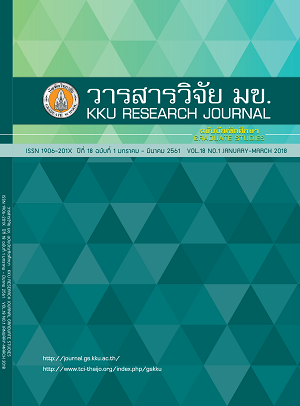ปัจจัยที่มีผลต่อศักยภาพในการเฝ้าระวังโรคไข้เลือดออกของประชาชนในชุมชนที่มีการระบาดของโรคไข้เลือดออกซ้ำซาก ตำบลท่าบัว อำเภอโพทะเล จังหวัดพิจิตร
Keywords:
ไข้เลือดออก (Hemorrhagic fever), ศักยภาพ (Potential), การเฝ้าระวังโรค (Surveillance)Abstract
การศึกษาวิจัยครั้งนี้เป็นการวิจัยเชิงพรรณนา (Descriptive Research) มีวัตถุประสงค์เพื่อศึกษาปัจจัยที่มีผลต่อศักยภาพในการเฝ้าระวังโรคไข้เลือดออกของประชาชนในชุมชนที่เคยมีการระบาดของโรคไข้เลือดออกซ้ำซาก ตำบลท่าบัว อำเภอโพทะเล จังหวัดพิจิตรและเพื่อศึกษาศักยภาพในการเฝ้าระวังโรคไข้เลือดออกของประชาชนในชุมชนที่เคยมีการระบาดซ้ำซากของโรคไข้เลือดออก กลุ่มตัวอย่าง คือ ตัวแทนของหลังคาเรือน จำนวน 324 คน เครื่องมือที่ใช้ในการศึกษาวิจัยครั้งนี้ เป็นแบบสอบถาม วิเคราะห์ข้อมูลด้วย สถิติเชิงพรรณนา และการวิเคราะห์ความถดถอยเชิงพหุแบบขั้นตอน (Stepwise Multiple Regression Analysis) ผลการวิจัย พบว่า ตัวแปรต้นที่มีความสัมพันธ์กับศักยภาพการในเฝ้าระวังโรคไข้เลือดออกของประชาชน มี 8 ตัวแปร ดังนี้ ทัศนคติต่อการดำเนินงานเฝ้าระวังโรคไข้เลือดออก การเป็นสมาชิกกลุ่มกองทุนเงินล้าน ความเพียงพอของเครื่องมือในการควบคุมและป้องกันโรคไข้เลือดออก อาชีพรับจ้าง ทักษะการใช้เครื่องมือ การศึกษาระดับปริญญาตรี การศึกษาระดับสูงกว่าปริญญาตรี ความคาดหวังในประสิทธิผลของการตอบสนอง และสามารถอธิบายความแตกต่างของศักยภาพการเฝ้าระวังโรคไข้เลือดออกของประชาชนตำบลท่าบัว ได้ร้อยละ 15.50
This study was a descriptive research aimed at studying the factors affecting the dengue hemorrhagic fever potential of people in dengue community, Tabua sub-district Phothalae district Phichit province and To study the potential for dengue hemorrhagic fever surveillance in people with dengue hemorrhagic outbreaks. The samples were 324 households. The instruments used in this study were as follows. Is a questionnaire Analyze data Descriptive statistics Stepwise Multiple Regression Analysis The results of the study revealed that the variables that correlated with the potential for dengue hemorrhagic fever surveillance were 8 variables as follows: Attitude toward dengue surveillance Membership of the fund. Sufficiency of tools to control and prevent dengue hemorrhagic disease. Bachelor degree Higher Education Expectations on the effectiveness of the response. And they can explain the difference in potency of dengue hemorrhagic fever among people in Tabua district at 15.50%
References
2. Sittisomboon M. Research Methodology. phitsanulok: Naresuan University Publishing House; 2004.
3. Noxktajan R. Effect of application program on the motivation theory for prevention of hypertensive disease prevention behaviors among high risk individuals. Journal of Phrapokklao Nursing College 2016; 27(2):16–28. Thai.
4. Hairi F, Ong CHS, Suhaimi A. A knowledge, attitude and practices (KAP) study on dengue among selected rural communities in the Kuala Kangsar district. Asia-Pacific Journal of Public Health 2003;15(1): 37–43.Thai.


